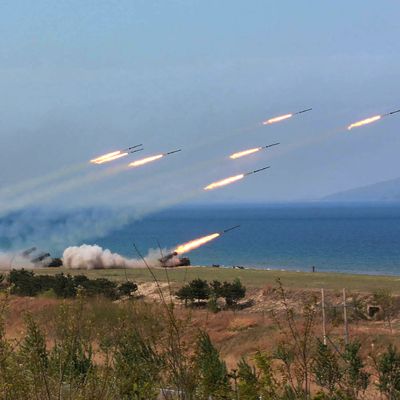
As North Korea’s nuclear-weapons program becomes more threatening (viz. the apparent launching of an intercontinental ballistic missile that could theoretically reach Alaska), even as its regime refuses to respond positively to truculent language from Donald Trump and his administration, military options for dealing with Pyongyang are inevitably on the table. That is certainly one way to interpret the president’s latest tweet about North Korea, which appears to dismiss his prior strategy of expecting China to control its sometimes-client in Pyongyang.
While maintaining a credible “deterrent” — a military threat against further aggressive moves by North Korea — makes sense, it is important to understand the limits of that strategy. The problem isn’t so much that Kim Jong-un and his governing clique are clinically insane and incapable of being “deterred” by the threat of extinction (that’s always possible, but after all, deterrence has worked to restrain madmen like Hitler and Stalin in the past). It is that Pyongyang is fully committed to its own deterrence strategy, based on the persistent belief that only by becoming a nuclear power can the regime avoid destruction by its many enemies, chiefly the U.S. The more North Korea is threatened, the more it will threaten. Here is one shrewd take on why terrifying the world is so important to North Korea:
Its carefully curated image of aggressive unpredictability is intended to preserve its authoritarian and regulated society and, as a result, its isolation. The North is unlikely to expose itself to the international community unless it can guarantee two things: the primacy and security of its leaders, and an effective military deterrent. And there are few deterrents as effective as nuclear weapons.
Add in Pyongyang’s long-standing projection of itself and its megalomanic leaders as world-historical titans — a sort of Mighty Mouse version of Vladimir Putin’s efforts to pretend that Russia is as powerful as it was at the height of the Cold War — and you have a regime that is constitutionally incapable of acknowledging that it is “deterred” from military action more than it “deters.”
To the extent North Korea’s vast strategic self-esteem is based on self-delusion, could the U.S. call its bluff with a preemptive military strike? Perhaps, but the cost would be more than most Americans would accept. Any armchair strategists who think it would be easy to “take out” the Kim Jong-un regime or its arsenal with some sort of “surgical strike” should take a long look at a New York Times report on U.S. military assessments of how a war with North Korea would actually play out.
Surgical analogies are totally inappropriate:
[A] pre-emptive American attack would very likely fail to wipe out North Korea’s arsenal, because some of the North’s facilities are deep in mountain caves or underground and many of its missiles are hidden on mobile launchers.
The North has warned that it would immediately retaliate by launching nuclear missiles. But predicting how Mr. Kim would actually respond to a limited attack is an exercise in strategic game theory, with many analysts arguing that he would refrain from immediately going nuclear or using his stockpile of chemical and biological weapons to avoid provoking a nuclear response from the United States.
If “many analysts” are wrong, of course, a quick nuclear attack on South Korea or Japan — if not, at this point, Alaska — could wreak horrifying damage, aside from the certainty of millions of casualties in North Korea itself in retaliatory strikes (not an optimal outcome, no matter what you think of North Koreans). But military conflict with North Korea need not “go nuclear” to become devastating:
North Korea has positioned as many as 8,000 artillery cannons and rocket launchers on its side of the Demilitarized Zone, analysts say, an arsenal capable of raining up to 300,000 rounds on the South in the first hour of a counterattack. That means it can inflict tremendous damage without resorting to weapons of mass destruction.
Nearly half of South Korea’s population lives within 50 miles of the DMZ. The Times quotes a 2012 study by the Nautilus Institute for Security and Sustainability that assessed the potential consequences of conventional combat across the border:
The Nautilus Institute study projects 60,000 fatalities in the first full day of a surprise artillery attack on military targets around Seoul, the majority in the first three hours. Casualty estimates for an attack on the civilian population are much higher, with some studies projecting more than 300,000 dead in the opening days.
If that number doesn’t shock you, consider that it is significantly higher than the combined death toll from the U.S. nuclear attacks on Hiroshima and Nagasaki.
Given the identity and temperament of the president of the United States, it is comforting that his Defense secretary understands the risks and costs of even limited military conflict with Pyongyang:
Defense Secretary James Mattis has said outright war with North Korea would be “catastrophic” and “probably the worst kind of fighting in most people’s lifetimes.”
All this suggests that whether we like it or not, North Korea does indeed have a credible deterrent against “aggression” by its enemies. And that deterrent might exist even if Pyongyang did not have nuclear weapons, though nukes make the risk of calling North Korea’s bluff probably too high to test.
There are famously no easy options for dealing with North Korea. No one should be under the illusion that the U.S. could “solve” the problem by simply flexing its muscles.






























